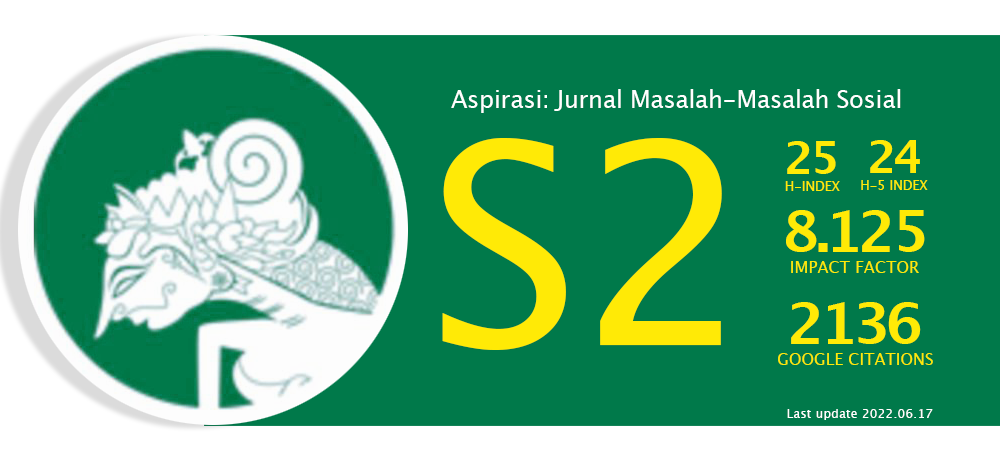Pengembangan Skala Orientasi Masa Depan Pendidikan pada Remaja Indonesia
Abstract
This study aimed to develop an instrument for education future orientation among adolescents in Indonesia, namely by confirming the future orientation model of Seginer, Nurmi, and Poole. The approach used is quantitative because statistical tests are needed to meet the psychometric requirements of an instrument. The researcher used Confirmatory Factor Analysis (CFA) with Lisrel program to test construct validity and single trial method with Cronbach Alpha technique with SPSS program to test reliability. Data collection was conducted online at the end of August 2021 for 3,238 adolescents in class XII of Public High School with a convenient sampling technique. Through CFA, it was confirmed that a unidimensional model was acceptable (RMSEA = 0.048, < 0.05), meaning that all items truly measure the education future orientation. In addition, it was also confirmed that the education future orientation consists of motivational, cognitive, and behavioral components according to the theoretical model of future orientation built by Seginer, Nurmi, and Poole. Meanwhile, based on the results of the reliability test, this instrument has high reliability, with a reliability coefficient of 0.905. Henceforth, this instrument can be used for educational research purposes on adolescents.
Abstrak
Penelitian ini bertujuan untuk mengembangkan instrumen orientasi masa depan pendidikan remaja, yaitu dengan mengonfirmasi model orientasi masa depan Seginer, Nurmi, dan Poole. Pendekatan yang digunakan adalah pendekatan kuantitatif karena uji statistika diperlukan untuk memenuhi persyaratan psikometrik dari sebuah instrumen. Peneliti menggunakan Confirmatory Factor Analysis (CFA) dengan program Lisrel untuk menguji validitas konstruk dan metode single trial dengan teknik Cronbach- Alpha dengan program SPSS untuk menguji reliabilitas. Pengumpulan data dilakukan secara daring pada akhir Agustus 2021 terhadap 3.238 remaja kelas XII SMA Negeri dengan teknik convenient sampling. Melalui CFA, terkonfirmasi bahwa model satu faktor dapat diterima (RMSEA = 0,049 (RMSEA < 0,05); GFI = 0,97 (GFI > 0,90); CFI = 0,99 (CFI > 0,90); NFI = 0,99 (NFI > 0,90)), artinya seluruh butir benar-benar mengukur orientasi masa depan pendidikan. Selain itu, terkonfirmasi juga bahwa orientasi masa depan pendidikan terdiri dari komponen motivasi, kognitif, dan perilaku sesuai model teoritikal orientasi masa depan yang dibangun Seginer, Nurmi, dan Poole. Sementara berdasarkan hasil uji reliabilitas, instrumen ini memiliki reliabilitas tinggi, dengan koefisien reliabilitas sebesar 0,905. Untuk selanjutnya, instrumen ini bisa digunakan untuk tujuan riset pendidikan terhadap remaja.
Keywords
Full Text:
pdfReferences
Azwar, S. (2018). Penyusunan skala psikologi (Edisi 2). Yogyakarta: Pustaka Pelajar.
Cohen, R. J., & Swerdlik, M. E. (2009). Psychological testing and assessment: an introduction to tests and measurement (7th Edition). USA: McGraw-Hill.
Desmita. (2008). Psikologi perkembangan. Bandung: PT Remaja Rosdakarya.
Erikson, E. H. (1968). Identity: youth and crisis. New York: Norton.
Frank, L. K. (1939). Time perspectives. Journal of social philosophy, 4, 293–312.
Guilford, J. P., & Frucher, B. (1978). Fundamental statistics in psychology and education. Tokyo: McGraw-Hill Kogakusha, Ltd.
Hair Jr, J. F., William, C., Babin, B. J., & Anderson, R. E. (2014). Multivariate data analysis (7th Ed). Harlow: Pearson.
Havighurst, R.J. (1974). Development tasks and education (3rd Ed). New York: McKay.
Hejazi, E., Naghsh, Z., Moghadam, A., & Saki, S. S. (2013). Validation of the future orientation questionnaire among Iranian adolescents. Journal of Educational Management Studies, 3(4), 487–491.
Hurlock, E.B. (2011). Psikologi perkembangan: suatu pendekatan sepanjang rentang kehidupan. Jakarta : Erlangga.
Husman, J., & Lens, W. (1999). The role of the future in student motivation. Educational Psychologist, 34(2), 113–125.
Israeli, N. (1932). The social psychology of time, comparative rating of and emotional reactions of the past, present, and future. The Journal of Abnormal and Social Psychology, 27(2), 209–213.
Jembarwati, O. (2015). Pelatihan orientasi masa depan dan harapan keberhasilan studi pada siswa SMA. Humanitas: Jurnal Psikologi Indonesia, 12(1), 45–51.
Kerpelman, J. L., & Mosher, L. S. (2004). Rural African American adolescents’ future orientation: the importance of self-efficacy, control and responsibility, and identity development. Identity: An International Journal of Theory and Research, 4(2): 187-208. doi: 10.1207/s1532706xid0402_5
Piaget, J. (1994). Cognitive development in children: Piaget Development and Learning, Journal of Research in Science Teaching, 2, 176–186.
Lefcourt, H. M. (1966). Belief in personal control: research and implications. Journal of Individual Psychology, 22(2), 185–195.
Leonardi, A. (2007). Future time perspective, possible selves, and academic achievement. New Directions for Adult and Continuing Education, 114, 17–26.
Lewin, K. (1948). Time perspective and morale. In K. Lewin (ed). Resolving social conflict (103-124). New York, NY: Harper & Brothers Publishers.
Markus, H., & Nurius, P. (1986). Possible selves. American psychologist, 41(9), 954.
Matsumoto, D. (Ed.). (2009). The Cambridge dictionary of psychology. UK: Cambridge University Press.
Nurmi, J. E. (1989). Adolescent’s orientation to the future: development of interest and plans, and related attributions and effects in the life span context (Thesis Dissertation). Finnish Society of Science, Helsinski.
Nurmi, J. E. (1991). How do adolescents see their future? a review of the development of future orientation and planning. Developmental Review, 11, 1–59.
Preska, L., & Wahyuni, Z. I. (2017). Pengaruh dukungan sosial, self-esteem dan self efficacy terhadap orientasi masa depan pada remaja akhir. Tazkiya Journal of Psychology, 5(1), 65–77. doi: 10.15408/tazkiya.v22i1.8160
Seginer, R., Nurmi, J. E., & Poole, M. E. (1991). Adolescent future orientation in cross cultural perspective: Research prospect, Paper presented at the 11th meeting of the ISSBD, Minneapolis.
Seginer, R. & Halabi-Kheir, H. (1998). Adolescent passage adulthood: Future orientation in the context of culture, age, and gender. International Journal of Intercultural Relations, 22(3), 298–217.
Seginer, R. & Mahajna, S. (2004). How the future orientation of traditional Israeli Palestinian girls links beliefs about women's roles and academic achievement. Psychology of Women Quarterly, 28(2), 122–135. doi: 10.1111/j.1471-6402.2004.00129.x
Seginer, R. & Noyman, M. (2005). Future orientation, identity and intimacy: Their relations in emerging adulthood. European Journal of Developmental Psychology, 2(1), 17–37.
Seginer, R. (2009). Future orientation: developmental and ecological perspectives. New York: Springer Science & Business Media.
Sugiyono. (2015). Metode penelitian kuantitatif, kualitatif dan R&D. Bandung: Alfabeta
Triwahyuni, A., Purwono, U., Sadarjoen, S. S., & Sapri, E. R. (2019). Pengembangan Millon Personality Type Inventory (MPTI) sebagai instrumen pengukuran kepribadian di Indonesia. Jurnal Psikologi Sains dan Profesi (Journal Psychology of Science and Profession), 3(2),65–74.
Trommsdorff. G., & Lamm, H. (1983). Future orientation and socialization. International Journal of Psychology, 18(1-4), 381–406. doi: 10.1080/00207598308247489
Trommsdorff, G. (1986). Future time orientation and its relevance for development as action. In R. K. Silbereisen, K. Eyferth & G. Ruding (eds.), Development as Action Context (pp. 121-136). Berlin: Springer.
Umar, J., & Nisa, Y. (2020). Uji validitas konstruk dengan CFA dan pelaporannya. JP3I (Jurnal Pengukuran Psikologi dan Pendidikan Indonesia), 9(2), 1-11. Doi: 10.15408/jp3i.v9i2.16964
Vidiyanto, E. (2006). Penyusunan modul pelatihan menyusun orientasi masa depan “planning your future” bagi remaja (Tugas Akhir). Pascasarjana Fakultas Psikologi UI, Depok.
Weiner, B. (1996). Human motivation: metaphors, theories and research. Newbury Park, CA: Sage.
DOI: https://doi.org/10.46807/aspirasi.v12i2.2495
Refbacks
- There are currently no refbacks.







